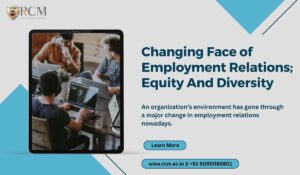The organization’s environment has gone through a major change in employment relations nowadays. It is through the employment relationship, however defined, that reciprocal rights and obligations are created between the employee and the employer.
It has been the main vehicle through which workers gain access to the rights and benefits associated with employment in the areas of labor law, social security& economic rights & development. The existence of an employment relationship is the condition that determines the application of the labor and social security law provisions addressed to employees.
It is the key point of reference for determining the nature and extent of employers’ rights and obligations towards their workers.
The issue has become more and more important because of the increasingly widespread phenomenon of dependent workers who lack protection because of one or a combination of the following factors:
- the scope of the law is too narrow or it is too narrowly interpreted;
- the law is poorly or ambiguously formulated so that its scope is unclear;
- the employment relationship is disguised;
- the relationship is objectively ambiguous, giving rise to doubt as to whether or not an employment relationship really exists;
- the employment relationship clearly exists but it is not clear who the employer is, what rights the worker has, and who is responsible for them; and
- Lack of compliance and enforcement.
Due to the above factors, the following need to be addressed which have become the burning issues nowadays in organizations.
- existence of employment relationships,
- ambiguous employment relationship
- disguised employment relationship
- gender disparity & employment relationship
- social &organizational culture & employment relationship
The formulation and application of a national policy for reviewing at appropriate intervals and, if necessary, clarifying and adapting the scope of relevant laws and regulations, in order to guarantee effective protection for workers who perform work in the context of an employment relationship. The establishment of an appropriate mechanism – or the use of an existing one – for monitoring developments in the labor market and the organization of work so as to be able to formulate advice on the adoption and implementation of measures concerning the employment relationship.
This study examines gender disparity in various sectors in India, its causes & measures to maintain a fair employment relationship in organizations. Like many other countries, this progress in India is also slow. The paper includes a discussion of the theoretical explanations for this and the extent to which these are borne out in India.
This group represents only a minority of women workers, and there are many other groups of women workers for whom constraints to women’s access to senior management may not be the most pressing issue. However, this study has chosen to focus on women in management in this paper.
Over the past decade, there seems to have been a reluctance to continue to address this group, despite the numerical evidence that women continue to be disproportionately represented in senior management positions. We believe it’s timely to refocus on women in management, gender disparity, equity issues & measures to have good employment relations.
It’s not enough to hire a bunch of employees who are different from one another; as humans, we need to feel included. We want to feel like we’re a part of what’s going on at our organizations, and that our time at work matters. This happens through inclusion.
Inclusion & Diversity:
Inclusion doesn’t just mean involvement; it’s about empowering people. Everyone wants to be excited about their work and to feel useful, and that really gets to the heart of inclusion. On the flip side, without inclusion, you see a negative impact on employee engagement and retention.
As diversity and inclusion expert Verna Myers says, “Diversity is being invited to the party; inclusion is being asked to dance.”
Here in diversity, this study relates to male and female employees, and their growth in various companies.
Around the world, female managers are concentrated in the lower management levels holding positions with less authority overall than men (Powell and Graves, 2003). The situation in India is comparable to that in other Western countries (Hale, 1996; Connell, 2006).
While the number of women at work has been increasing steadily over the past 25 years, evidence suggests that women are not moving into management positions in large numbers. The Census of Women in Leadership (2006) shows that women held 3 percent of CEO positions (compared to 2% in 2002) and 8.7 percent of Directorships (compared to 8.2 percent in India’s corporate world
In comparison to most countries, India has legislated for a reasonably comprehensive system of equal opportunity legislation. As well as a range of anti-discrimination legislation preventing discrimination on the grounds of gender (among a large number of other grounds), legislation specific to equal employment opportunity for women has been in place since 1986.
Now the Equal Opportunity for Women in the Workplace Act 1999, the legislation covers all organizations in the private sector with more than 100 employees and requires all employers to develop annual and now biennial progress reports on their approach to employee environment and opportunity (EEO) and policies of implementation as well as the numbers of men and women employed across all employment role.
Equity:
Despite the obvious inequity within the management ranks, achieving equity in the workplace has not maintained a steady momentum in India. A shift from equal employment opportunity to the managing diversity discourse has resulted in a change of focus, away from addressing the historic and systemic discrimination of groups, particularly women, toward delivering work and family balance policies that focus on individual differences (Strachan, Burgess, and Henderson 2007).
This shift has been more acceptable in the conservative Indian culture and more tolerable in India’s macho culture with its lack of acceptance of women as leaders (Still 2006) and is evidenced by the significant reduction in resources directed to the state and federal bodies providing policy advice on women since the late-1990s (Bacchi, 1999; 2000; Maddison, 2004; Summers, 2004).
As a result, equal opportunity has been sidetracked from delivering equitable treatment through fair programs of recruitment and selection, training and development and promotion and transfer to women as a group to the increased delivery of family-friendly policies and flexible hours to all individuals at work The prospects for increasing the numbers of women in management remain limited (French, 2001; French and Maconachie,2004; and French and Strachan, 2007)The social and economic relevance of work and employment relations is as great today as it has been in the past and is likely to be of even greater importance in the future.
Yet, as a field of academic study, traditional approaches to work and employment relations face a number of challenges, particularly in an era of globalization. Understanding the changing nature of work and employment relations has significant implications for economic prosperity and social harmony in all societies. How workers engage in new forms of employment, such as the ‘shared economy’, and exercise influence over their employment conditions are challenges that face not only employers but also governments and society at large.
As the world of work becomes increasingly affected by global as well as local factors, a multi-level perspective is needed that takes into account the interaction between national, sectoral, and transnational spheres of work and employment relations.
Diversity:
When we talk about managing diversity, the reason we use the term “managing” is because it’s an active term — and diversity requires action.
Diversity matters, but inclusion is really the key.
Gender Disparity in Various Sectors– Present Era
Supporting Hede and O’Brien’s predictions for slow increases, the numbers of women in management today show little improvement. In the 2006-07 report by the EOWA, employee data from 2,676 of the 2,701 private sector organizations registered with the Agency indicated 2,725,088 people were employed – an increase from 2,640,627 in 2011-13, of which approximately 47.2% or 1,048,816 were women. However only 34% of managers were women and only 9.8% of CEOs were women (EOWA, 20014).
These national figures are replicated fairly consistently across regional areas in India. While it is often assumed that regional and rural India are more conservative than metropolitan locations, when considering women’s representation in management across the different locations, there are no significant differences.
Table 1: Women in management by region (As per EOWA, 2014)
| Region | Number | % |
| Major cities | 269178 | 35 |
| Inner regional | 78000 | 34 |
| Outer regional | 51951 | 34 |
| Remote | 10217 | 34 |
| Very remote | 3919 | 36 |
| Other | 375 | 34 |
| Total | 413640 | 34 |
In unpacking women’s representation in management further, we can see that their representation across industries highlights some interesting patterns. As can be seen in Figure 1, the industry sectors where women have the largest share of management positions are health care and social assistance (65%), education and training (56%), and accommodation and food services (48%) – industries traditionally associated with ‘nurturing’, which can be seen as highly feminized.
Figure-1Barriers that restrict diversity &numbers of women in management
Individual Factor
Much of the early work on women’s absence from management positions tended to assume that women were in some ways ‘deficient’. As noted by Kanter (1976: 283) underpinning this focus were assumptions that: women differ from men in their character, temperament, attitudes, self-esteem, language, gestures, and interpersonal orientation, whether by nature, early socialization, or accumulated learning as a result of coping with an inferior position.’
Women’s absence from senior management was then attributed to these differences and the argument was that if women addressed these differences through training or other developmental opportunities and so gained the characteristics needed to perform management, they would progress into senior management. It would just be a matter of time–as the pipeline argument would hold
Social Factor
Relevant to any discussion about women’s access to management is the placing of the individual and organization in the broader context of social norms and recognizing how organizational practices and behaviors observed within organizations both reflect and construct these. Organizations do not operate in a vacuum and must be considered within the wider society they inhabit and interact with (Collins, 1998). In this context, the prescriptive nature of gender stereotypes provides insights into the barriers women face in senior management.
Gender stereotypes define our culturally agreed-upon notions of gender-appropriate (and gender-inappropriate) behaviors and traits. These notions have been reflected in the gendered division of labor within the home and are constantly reflected and constructed in popular culture. As well, they flow through the educational and employment choices and prospects of men and women (Golombok&Fivush,1994). Traits associated with males tend to be more highly regarded than traits associated with females (Heilman,1997). Being strong, independent, and prepared to take risks is viewed much more favorably in the public sphere than the feminine images of being dependent, weak, and easily influenced.
As Collinson and Hearn(1996) note, in a gender, hierarchical, and class sense it is professional men and men in management, who most closely resemble hegemonic masculinity. It is the successful claim to authority that marks hegemony (Connell, 1995). The power of the socially constructed images in framing who is seen as management material was well established through the seminal work of Schein(1973) and has been reinforced through more recent studies (Schein,1993; Dealand Stevenson,1998; Sczensy, (2003)
Organizational factors
At the organization level, a significant body of work has developed, critiquing the practices within organizations that are assumed to be gender neutral, yet on closer analysis can be reconstructed as saturated with male values (Acker,1990;1998; CalasandSmircich,1992), impacting on women’s and men’s experiences within the workplace.
‘Face-time’ is one of the most common examples used to illustrate the argument that organizational practices are gendered. Facetime is a term used to describe the requirement that aspiring managers be seen on the job for long hours. This requirement reflects the traditional working patterns of men who had a spouse who was responsible for the private sphere, allowing them to focus on public (paid)work. As we do not have very refined measures for assessing managerial performance, proxies such as FaceTime are often unquestioningly used in assessing someone’s suitability for the job.
The continued unequal division of labor in the household means that, more often, this works against women than men. Related to the expectation that employees will spend long hours in the workplace is the gendered nature of the traditional career models operating in organizations.
Through her examination of the career development of women and men, Wajcman(1999) concludes that the corporate career is gendered. She notes that the classic career is predicated on the male lifecycle and that entry into senior management is ‘dependent on implicit criteria of visibility and acceptability that are, in turn, a function of the men’s network.’ The impact of this on selection decisions, especially those in senior management positions, is well established (Powell and Graves,2003).
Another factor frequently cited as limiting women’s entry into the most senior ranks of an organization is that they are not perceived by those in power to ‘fit in’ with the established norms. Because women are not like those in power already, they are kept out of the inner circles. Kanter (1977) in her book, Men and Women of the Corporation, examined these issues in considerable detail. Her labeling of his tendency like to promote like as homo social reproduction made explicit what many had simply been aware of, but not able to articulate.
Equity Policies: Remuneration
Further to the strategy and structure debates in addressing gender disparity, management policy has also been identified as providing a means to overcome it. Kanter (1976) identified three different policy types used in procedural equity management & gender disparity. Remuneration, Social structural policies, and culture within the organization.
To accommodate differences; role-related policies related to addressing specific differences between men’s and women’s roles at work and home; and temperamental policies related to overcoming the often identified deficiencies of women’s knowledge, skills, and abilities at work. Sheridan (1998) found policy types used were somewhat different, identifying different strategic goals and the use of opportunity policies, used to increase women’s career opportunities.
French and Maconachie (2004) further identified specific policies that offer support and inclusivity to women, particularly in those areas lacking substantial numbers of women such as non-traditional areas of work and in management. Sheridan(1998) points to the wide range of policy types based on different objectives highlighting the difficulty of policy determination In implementing equal employment opportunity.
The EEO legislation requires organizations to undertake an analysis of workplace policies and practices in conjunction with the formation of the demographics of the organization with a view to strategic change. Workplace practices must be analyzed and addressed through seven employment are as named in the legislation, namely: recruitment and selection; promotion, transfer, and termination; training and development; work organization; conditions of service; arrangements for dealing with gender-based harassment; remuneration & other benefits.
The study further examined the relationship between the equity management policies implemented and the number of women in management. While there was a significant result, organizational size was the only contributing factor in the increased numbers of women in management. None of the strategic activities across any of the policies are as were significant indicators of increased numbers of women in management.
The strategy, structure, and policy options for managing equity and diversity have confounded the determination, implementation, and outcomes of equal employment opportunity and diversity management. While it is wise to remember the cautions and cave that equal employment opportunity is an ineffectual gift horse due to the multidimensional nature of the disadvantage of women at work (Poiner and Will1991). Other studies have indicated mixed results on the effectiveness of organizational approaches to managing equity in diversity & maintaining a good employment relationship.
A study of women in the banking industry (Metz,2003) found women were advancing into management chiefly on their own merits: their knowledge and their skills, indeed their human capital, supporting Ragins and Sandstorm’s(1989) model that women’s managerial advancement is principally related to factors in the individual environment including education levels and years of work experience and access to supportive for women with children rather than any organizational factors. Yet, in a small study of early career women (n=98) in Australia, five areas of organizational practice for supporting and developing professional and managerial women were examined.
All five areas; management; policies/resources; administration; training and development; recruiting and external relations; were significantly and positively inter-correlated indicating that organizations performing at high(or low) levels in one area were performing at high (or low) levels in others. The women describing more supportive organizational practices also indicated more job and career satisfaction and higher levels so psychological well-being (Burke, Burgess, and Fallon,2006).
These studies should have a direct influence on organizational practice. Findings indicate that explicit gender conscious decision-making in the social structural policy areas of recruitment and selection; promotion and transfer; and training and development that support women and their career need scan and do offer positive outcomes both in well-being and in providing links with increased numbers of women in management.
While considerable progress may be made in encouraging women to work by integrating work and family opportunities and better conditions of service, this is the soft option in equal opportunity to pacify the masses. Without explicit support by top management for women at work substantive change in the numbers of women in management will remain for a long time coming. A much equal opportunity in management& employment relationship still needs to be worked upon.
When we fail to manage diversity, employee relations issue arises. Some ways to mitigate these types of issues are:
- To develop clear anti-discrimination policies and enforce them consistently and fairly
- To promptly investigate any complaints by employees
- To learn the art of de-escalation, especially around issues of diversity
- To maintain fair remuneration without gender discrimination.
- Immediate Actions
Steps need to be taken to begin turning diversity into an asset for organizations maintaining employee relationships.
- Examine workforce:
- Assess managers’ skillsets:
- Reviewing of company plan:
- Explore the forms of workplace currency in place at your organization
Conclusion
There is no doubt that women’s rates of participation in the paid workforce are increasing. What has stalled, though, is their progress through the hierarchy. The result has been that women can move in and out of the workforce more easily, but they remain proportionately clustered in the lower levels of the organization because the fundamental structures and expectations of career profiles remain unchanged; continuous and uninterrupted progress up the career ladder remains the norm.
Legislation remains crucially little has changed in the past 10 years. Arguments regarding the various perspectives of EEO and its implementation are rarely, challenged or addressed in the organization’s report on their implementation of EEO developing employment relations.
Many HR respondents indicate the importance of addressing the perspective of treating all employees “equally” with limited acknowledgement that the treatment of unequal people in an equal manner may amount to discrimination. In addition, there remains little acknowledgment of the earlier calls by feminist scholars to challenge the underlying cultural assumptions about time(Bailyn,2002;2006).
This includes time devoted to work–and even more importantly time seen to be at work. Time continues to be a common proxy for the measurement of the individual’s potential for senior management. Inclusion, managing diversities, equity in re-remuneration, and organizational policies are some of the major areas that need to be focused upon to have a good employment relation in an organization leading to employee as well as organizational growth.
References
Acker, J.,1990.‘Hierarchies, Jobs, Bodies: A Theory of Gendered Organizations.GenderandSociety,4:2,139-158. Alvesson, M., and Billing, Y.D., 2000.UnderstandingGenderandOrganizations, London: Sage.
Bacchi, C. (1999), Rolling back the state? Feminism, theory, and policy, in
Hancock, L. (Ed.), Women, Public Policy and the State, Macmillan, Melbourne, pp.54-69.
Bacchi, C. (2000), ‘The see-saw effect: down goes affirmative action, up comes workplace diversity’’, Journal of
InterdisciplinaryGenderStudies, Vol.5 No2, pp.64-83.
Ragins,B.R.andSundstrom,E.,(1989)“Genderandpowerinorganizations:alongitudinalperspective”,Psychological
Bulletin,105(1)pp. 51-88. Vilkinas, T.(1988)“Do women use different influences?” Women in ManagementReview,3 (3),155-160.

















17 Comments
My cousin recommended this website to me, however I’m not sure if he wrote this post because no one else has such in-depth knowledge of my problems. You are amazing, thanks.
I had a great time with that, too. Despite the high quality of the visuals and the prose, you find yourself eagerly anticipating what happens next. If you decide to defend this walk, it will basically be the same every time.
Thanks to the high-quality content and the administrator’s active involvement, the site’s reputation will undoubtedly improve soon.
I was suggested this web site by my cousin. I’m not sure whether this post is written by him as no one else know such detailed about my trouble. You are incredible! Thanks!
I loved even more than you will get done right here. The picture is nice, and your writing is stylish, but you seem to be rushing through it, and I think you should give it again soon. I’ll probably do that again and again if you protect this hike.
Thank you for the auspicious writeup It in fact was a amusement account it Look advanced to far added agreeable from you However how can we communicate
For days now I’ve been glued to this gem of a site. The owner works tirelessly to engage fans with quality content. I’m mega impressed and can’t wait to see what they wow me with next!
This will be very useful for my next project, thank you for the detailed information.
I was recommended this website by my cousin I am not sure whether this post is written by him as nobody else know such detailed about my trouble You are amazing Thanks
Its like you read my mind You appear to know so much about this like you wrote the book in it or something I think that you can do with a few pics to drive the message home a little bit but instead of that this is excellent blog A fantastic read Ill certainly be back
Wow, wonderful blog layout! How long have you been blogging for? you make blogging look easy. The overall look of your site is great, as well as the content!
Usually I do not read article on blogs, however I would like to say that this write-up very compelled me to take a look at and do it! Your writing style has been amazed me. Thank you, very nice article.
Excellent blog here! Also your website loads up very fast! What web host are you using? Can I get your affiliate link to your host? I wish my web site loaded up as quickly as yours lol
Wow, superb blog layout! How long have you been blogging for? you make blogging look easy. The overall look of your site is magnificent, as well as the content!
I have been browsing online more than three hours today, yet I never found any interesting article like yours. It is pretty worth enough for me. In my view, if all website owners and bloggers made good content as you did, the internet will be a lot more useful than ever before.
Hello my loved one! I want to say that this post is amazing, great written and include almost all significant infos. I would like to look extra posts like this.
Hi, Neat post. There is a problem along with your website in internet explorer, would test this·IE still is the market chief and a good section of other folks will pass over your magnificent writing due to this problem.